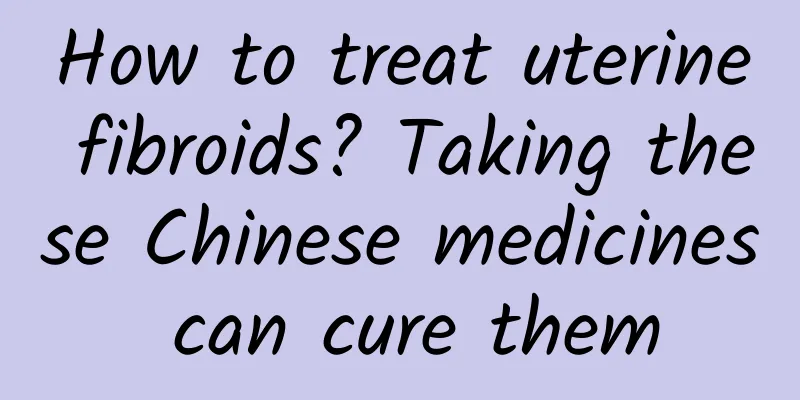How to treat uterine fibroids? Taking these Chinese medicines can cure them

|
What Chinese medicine is good for uterine fibroids? Uterine fibroids are a type of female disease, and the cause of the disease is not very clear. Let me tell you what Chinese patent medicine to take for uterine fibroids? What are the dietary taboos? Take uterine fibroids seriously. When you find out that you have the disease, you must treat it seriously to avoid more serious harm. Uterine fibroids are benign tumors that originate in the uterus. It is not clear why women develop uterine fibroids. Most women with uterine fibroids have no symptoms. However, fibroids can cause a number of symptoms, depending on their size, location within the uterus, and their proximity to adjacent pelvic organs. These are most commonly abnormal bleeding, pain, and pressure. Uterine fibroids are diagnosed through a pelvic exam and ultrasound. If uterine fibroids need to be treated, surgery (hysterectomy, myomectomy, cryosurgery), MRI-guided high-intensity focused ultrasound (MRGFU or HIFU), and uterine artery embolization (UAE) are options. Drug treatments include mifepristone (RU-486), danazol (Danol), raloxifene (Evista), gonadotropin-releasing hormone analogs (Lupron, etc.), and low-dose oral contraceptives. What are uterine fibroids? What do they look like? Uterine fibroids are benign tumors that originate in the uterus (womb). Although they are composed of the same smooth muscle fibers as the uterine wall (myometrium), they are denser than normal myometrium. Uterine fibroids are usually round in shape. In most cases, fibroids do not cause pain or other symptoms. However, unusually large uterine fibroids may put pressure on the bladder or other organs, leading to specific symptoms. Uterine fibroids are often described based on their location within the uterus. Subserosal fibroids are located beneath the serosa (the lining on the outside of the uterus). These usually appear on the outer surface of the uterus or may be attached to it by a pedicle. Submucosal (under the mucosa) fibroids are located in the uterine cavity beneath the endometrium. Intramural fibroids are located within the muscle wall of the uterus. Pedunculated fibroids grow on a stalk of tissue called a pedicel (like a mushroom) that extends from either the inside of the uterine cavity or the outside surface of the uterus. Uterine fibroids are common, a benign tumor of the female reproductive organ, also known as uterine fibroids, fibroids that enter the myometrium, subserosal fibroids, submucosal fibroids, and cervical fibroids. Chinese medicine calls them "Shijia" and "blood poison", mainly concentrated in women aged 35-50. 1. Qi stagnation and uterine fibroids. Treatment: promote qi and remove stagnation, activate blood circulation and eliminate symptoms. Prescription: 10g of costus root, 15g of clove, 25g of three-edged lancea, 15g of bitter orange, 25g of curcuma, 10g of green peel, 15g of Chuanlianzi, 15g of fennel, which can be decocted in water or ground into fine powder and made into water pills for oral administration. For irregular menstruation, add 20g of salvia miltiorrhiza and 15g of cyperus. For excessive vaginal discharge, add 15g of Poria, 15g of coix seed, and 10g of Angelica dahurica; for severe abdominal pain, add 15g of Corydalis yanhusuo and 15g of Panax notoginseng. 2. Blood stasis treatment of uterine fibroids. Treatment method: activate blood circulation and remove blood stasis, eliminate symptoms and resolve knots. Prescription: 15g of cinnamon twig, 20g of Poria, 20g of Cortex Moutan, 15g of Paeonia lactiflora, 15g of peach kernel. It can be decocted in water for oral administration, or ground into fine powder and made into water pills for oral administration. For excessive menstruation or continuous metrorrhagia, add 15g of Pollen Typhae and 20g of Ophiopogon japonicus; for excessive vaginal discharge, add 15g of Coix seed and 10g of Angelica dahurica; for severe abdominal pain, add 15g of Corydalis yanhusuo, 15g of frankincense, and 15g of myrrh. Patients with uterine fibroids should not only receive treatment, but also pay attention to dietary taboos. 1. Stay away from irritating foods: Uterine fibroids are also a disease caused by inflammation in the body, so you should be careful about your diet, especially avoid eating irritating foods that may aggravate the condition, such as mutton, beef, dog meat, seafood, eel, salted fish, black fish, etc. These foods may aggravate the condition. 2. Stay away from hot foods: Women with uterine fibroids are prone to anemia. Long-term anemia has a great impact on women's health. Therefore, many patients with uterine fibroids choose to eat tonics such as longan, red dates, and donkey-hide gelatin to replenish blood. In fact, this is a misunderstanding. Because hot foods consumed during the illness will lead to the aggravation of fibroids. 3. Stay away from spicy foods: Patients with uterine fibroids should avoid all spicy foods as much as possible, such as peppers, ginger, beef, mutton, seafood, coffee, alcohol, etc. Spicy foods will only aggravate the condition, increase the difficulty of healing, prolong recovery time, and cause greater physical harm to patients. |
<<: What does cervical warts look like?
>>: Will uterine fibroids disappear after pregnancy?
Recommend
Treatment of Haemophilus vaginitis
Haemophilus vaginitis is a vaginitis caused by in...
Why does premature ovarian failure occur?
Why does premature ovarian failure occur? Prematu...
Introduction to the hazards of endometrial tuberculosis
Some women think that the endometrium will shed e...
What are the dangers of uterine fibroids in the elderly? What are the causes of uterine fibroids in the elderly?
What are the dangers of uterine fibroids in the e...
Experts briefly analyze the common symptoms of chronic cervicitis
The symptoms of chronic cervicitis are a matter o...
What is the difference between adenomyoma and uterine fibroids?
Adenomyoma and uterine fibroids are common gyneco...
Family members must pay attention to the specific symptoms of patients with ectopic pregnancy
Ectopic pregnancy is a very harmful disease that ...
What medicine will the doctor prescribe after a woman has an abortion? How long should the doctor take the medicine prescribed after the abortion?
You should also take good care of your body durin...
What are the causes of vulvar leukoplakia?
What are the causes of vulvar leukoplakia? Vulvar...
To prevent dysmenorrhea, you should pay attention to some dietary taboos
Many women confuse dysmenorrhea with normal menst...
What is the difference between threatened miscarriage and abortion?
Threatened miscarriage mainly refers to the sympt...
Symptoms of vulvar leukoplakia at different stages
The symptoms of vulvar leukoplakia are a topic of...
Treatment of adnexitis based on syndrome differentiation and treatment in traditional Chinese medicine
Grandma Yang is 65 years old. She has been feelin...
Common causes of vulvar leukoplakia
The cause of vulvar leukoplakia is relatively com...
Is it dangerous to go back to work right after an abortion?
It is dangerous for women with weak constitution ...









